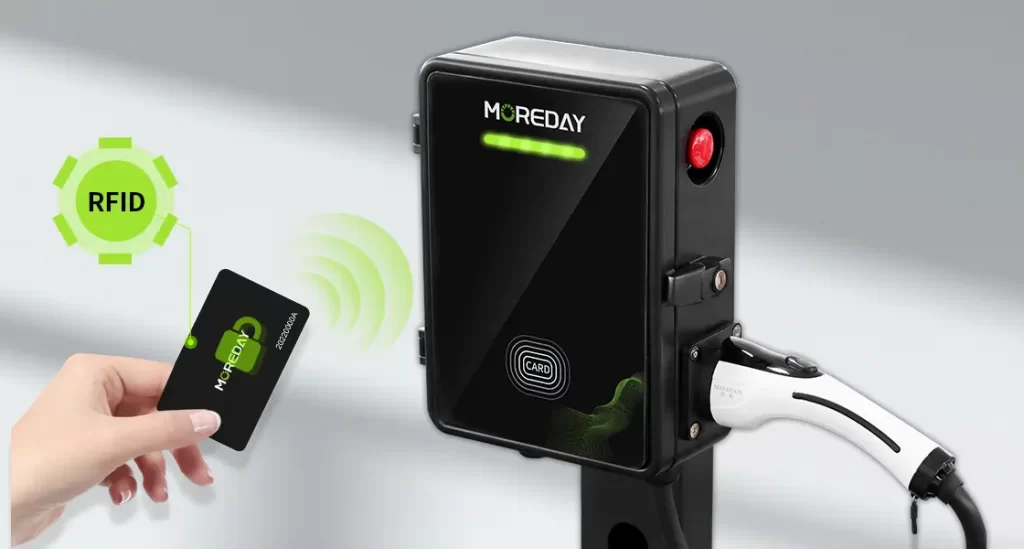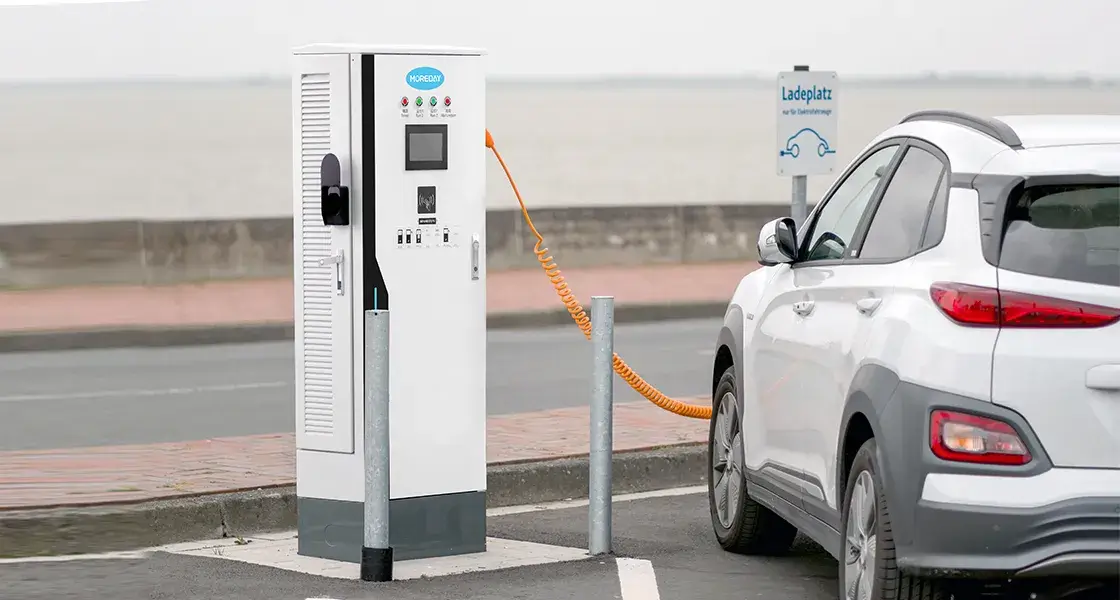One of the biggest concerns for electric vehicle (EV) owners is understanding vehicle charging, this article explores what EV charging is, how it works and how to choose it, let’s read it together!
What is EV charging?
Electric vehicle charging refers to the process of charging an electric vehicle (such as an electric vehicle or plug-in hybrid vehicle) by connecting it to a power source. Electric vehicle chargers come in many forms to meet different charging needs, allowing electric vehicle owners to conveniently charge their vehicles at home, work or public places.
Types of EV charging

There are many types of EV chargers, each offering different charging speeds and compatibility with EVs. The following are the main types of electric vehicle charging:
1. Level 1 EV charging
Level 1 chargers are the most basic type of EV charger and typically use a standard 120-volt household outlet. For electric vehicles, Level 1 chargers usually take longer, typically 8-20 hours to complete charging. Level 1 chargers are suitable for electric vehicles with small battery capacity and short daily driving range.
2. Level 2 EV charging
Level 2 chargers charge faster than Level 1 chargers, typically taking 4-8 hours to complete, and require a 240-volt power source. These chargers are commonly found in residential settings, workplaces, and public charging stations. They are ideal for electric vehicles with larger batteries and longer driving ranges, providing a faster way to charge the vehicle’s battery.
3. Level 3 EV charging
Level 3 chargers, also known as DC fast chargers, these high-power chargers can provide a large amount of energy to the vehicle battery in 1-3 hours, suitable for long trips or quick charging during the day.
Each type of EV charger offers distinct advantages and considerations based on an individual’s driving habits, access to charging locations, and the specific requirements of their electric vehicle.
How does EV charging work?

Electric vehicle (EV) charging works by transferring electrical energy from a power source to the vehicle battery to charge it. The electric vehicle charging process involves several key components and steps to ensure efficient transfer of power to the vehicle battery. Let’s dig into the basics of how electric vehicle charging works:
1. Electric vehicle connectivity
When the electric car needs charging, it connects to the electric car charger via a compatible charging cable. The connector at the end of the cable is designed to plug securely into a vehicle’s charging port, establishing a connection for transferring power.
2. Power input and conversion
Once connected, the EV charger draws power from its power source, which can be a standard household outlet for Level 1 chargers, or a specialized power source for Level 2 and 3 chargers. The charger then converts this electrical input into a form that is compatible with the vehicle’s battery system, ensuring safe and efficient energy transfer.
3. Battery communication
Modern electric vehicles are equipped with sophisticated battery management systems that communicate with the electric vehicle charger during charging. This communication allows the charger to adjust its output based on factors such as battery temperature, state of charge and voltage levels, optimizing the charging process for maximum efficiency and safety.
4. Charging control
Electric vehicle chargers regulate the flow of electricity to the vehicle’s battery, controlling factors such as current and voltage to ensure proper charging without overloading or damaging the battery. This precise control can effectively maintain the life and performance of electric vehicle battery packs.
5. Charging progress monitoring
During the charging process, both the EV charger and the EV monitor the progress of the charging process. This monitoring includes tracking parameters such as charging rate, time remaining to a full charge, and any potential issues or malfunctions that may occur during charging.
6. Completion and Disconnection
Once the EV’s battery reaches the required state of charge or reaches a predetermined time limit, indicating that it has received sufficient energy from the EV charger, the charging process is complete. At this point, both ends of the charging cable are safely disconnected from each other for safe storage or further use.
By understanding these basic steps involved in charging an electric vehicle, electric vehicle owners can make sure they charge their vehicle while ensuring optimal performance and longevity of the battery.
How to choose EV charging?
When considering an EV charger choice, EV owners must evaluate their specific charging needs and preferences. Here are some tips and factors for choosing an electric vehicle charger:
1. Charging speed and compatibility
The first things to consider when choosing an EV charger are the required charging speed and compatibility with EVs. Level 1 chargers are suitable for individuals with lower daily mileage, while Level 2 chargers provide faster charging capabilities for those with larger batteries or longer commutes.
2. Home charging and public charging
Electric vehicle owners should determine whether they rely primarily on home charging or regularly use public charging stations. For those who primarily charge at home, a Level 2 charger installed in a residential environment may be the most practical option.
On the other hand, individuals who frequently rely on public charging infrastructure should consider using a portable Level 2 charger or using a Level 3 fast charging station to charge on the go.
3. Installation requirements
Before selecting an electric vehicle charger, it is important to evaluate the installation requirements associated with each type of charger. Level 1 chargers typically require minimal installation because they plug into a standard household outlet.
However, Level 2 chargers typically require professional installation of a dedicated circuit and an appropriate power source, especially if installed in a residential or commercial environment.
4. Portability and flexibility
For EV owners who value portability and flexibility, portable EV chargers provide a convenient solution for on-the-go charging needs. Portable Level 2 chargers allow users to take advantage of a variety of power sources while traveling or visiting public charging stations, without having to rely solely on a fixed installation at home or work.
How to install EV charging?
The following are the detailed installation steps for charging piles at different levels: Level 1, Level 2 and Level 3:
1. Level 1 Charger
Confirm Power Requirements: Check if there is an available standard 120-volt outlet at home.
Check Circuit Capacity: Ensure the outlet is on a dedicated circuit to avoid overloading.
Inspect Wiring and Outlet Safety: Ensure that the wiring and outlet are free of damage and meet safety standards.
Connect the Charger: Plug the Level 1 charging cord that comes with your vehicle into the EV and the 120-volt outlet.
Test the Charging: Perform a test charge to ensure everything operates correctly before regular use.
2. Level 2 Charger
Select an Appropriate Location: Choose a location that is conveniently close to the main power supply and accessible for your electric vehicle.
Upgrade Electrical System: Contact a professional electrician to evaluate if a separate 240-volt circuit is needed based on the existing home power system.
Apply for Necessary Permits: Apply for building and electrical permits required for the installation as per local regulations.
Install Charging Station: Have a certified electrician install the charging station, including wiring, circuit breakers, and the charger itself.
Electrical Inspection and Testing: After installation, conduct necessary electrical safety checks and a test charge to ensure everything functions properly.
3. Level 3 Charger
Location and Power Assessment: Given the high power requirements of Level 3 chargers, typically involves coordination with the local power company to determine installation site and assess major power upgrades.
Engineering Design and Planning: Carry out detailed engineering design, including necessary power equipment and infrastructure layout.
Obtain Necessary Regulatory Approvals: Apply for and secure all necessary local and national construction and power-related permits.
Professional Installation and Connection: Installation of high-voltage equipment and the charger should be done by qualified professionals.
Major Power Connection and Testing: After equipment installation, connect to power, ensure all systems are safely operational, and then perform a charging test.
When installing the charger, consult a professional as needed to ensure the installation complies with local regulations and safety standards.
Summary
In summary, understanding the different EV chargers and how they work allows EV owners to make an informed decision when choosing a car charger.
Of course, when choosing an electric vehicle charger, factors such as charging speed, compatibility with electric vehicles, installation requirements, smart charging capabilities, and portability should be carefully evaluated. You can choose the EV charging suitable for your car in Moreday.
Related reading: Why use EV charging stations?


